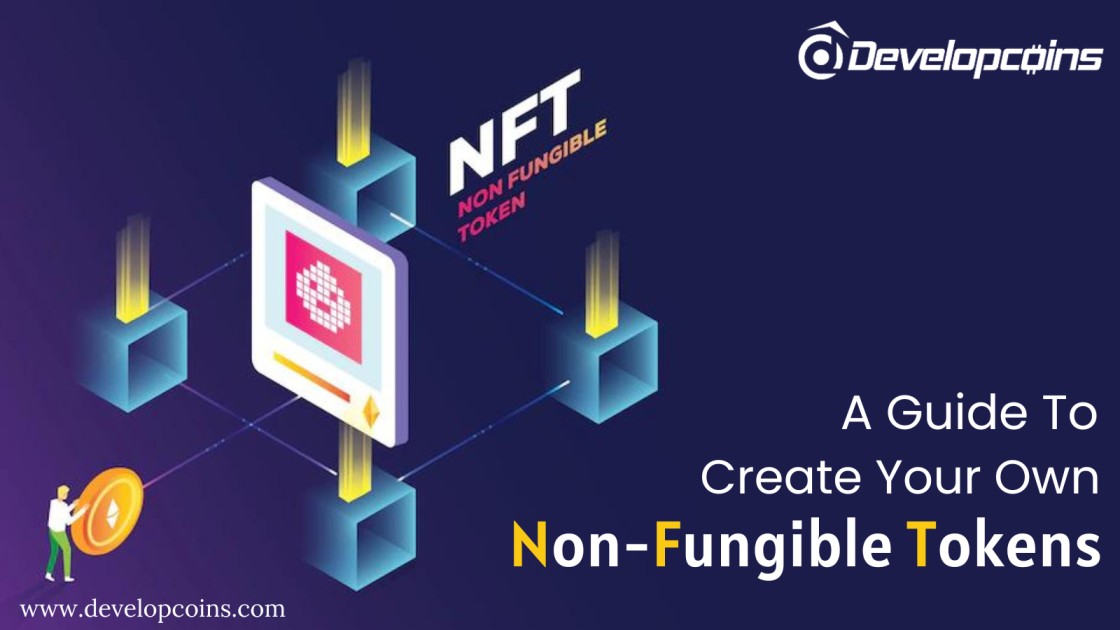

Developcoins, as a leading NFT Development company offers you the ultimate step-by-step guide that will help you understand how to create your own Non-Fungible tokens.

In this recent technological era, NFTs aka Non-Fungible Tokens have grown to be one of the most liked use case of blockchain technology. It has now become the popular way of generating hefty revenue for creators and artists. This article will show you how to make an NFT. But before we get into the details, let's first define a non-fungible token.
A Non-fungible token is a digital identifier stored in the blockchain which cannot be modified, replaced, or copied. A non-fungible token essentially serves as ownership documentation and also certifies a digital asset's legitimacy. As blockchain networks serve as a distributed ledger, these certificates are immutable. Such NFTs can be developed on a wide range of Blockchain networks like Binance Smart Chain, Cardano, Cosmos, Ethereum, EOS, Solana, Polkadot, and TRON.
Here is a step-by-step guide for how to create and list your NFT on a website.
First, pick an Marketplace before selling your NFT. A minimal number of markets utilize various blockchains. Do checkout the top NFT marketplaces and the blockchains they employ are listed below in this section.
Lazy minting methods are what OpenSea and Rarible use. In other words, these marketplaces allow you to create NFTs for free! By creating an NFT without uploading it to the blockchain, lazy minting allows you to save on gas costs. You can then upload it for sale on the market.
You need wallets to hold your digital assets, including any NFTs that you intend to make or buy. A cryptocurrency wallet stores and makes your private keys available in a secure manner. There are physical and digital variations of these wallets.
Your digital assets that are recorded on the blockchain are not actually stored in a crypto wallet. The private keys (passwords) that allow you to access your crypto assets, such as bitcoins and NFTs, are stored there instead. Your ownership of a cryptocurrency asset is confirmed by these private keys kept in your wallet.
Coinbase Wallet
MetaMask
TrustWallet
Ledger Nano
Electrum
BlueWallet
Exodus
WalletConnect
Create your crypto wallet shortly after signing up for a product or service. But keep in mind the 12 arbitrary words that Coinbase and MetaMask generate for your profile as your seed phrase. While setting up your account on a new device, you must use this seed phrase. So, it will be a good idea to preserve them carefully in a convenient spot.
You must connect your cryptocurrency wallet to the marketplace where you plan to create and sell your NFT after putting it up. To sell your NFT, for instance, go to their website and select "create." You'll be taken to a new tab with a list of well-known crypto wallets that work with the specific website.
You can decide which cryptocurrency wallet you want to link to your account. That's it; the marketplace will now be accessible through your wallet.
Now let's get to the meat of the matter: creating your NFT. Here is the process of creating an NFT listed below,
Checkout the website.
Simply Create a Collection.
Fill out all of the required fields.
Choose the blockchain for which NFT should be minted. You can select Ethereum or anyother popular blockchain network.
Cross-check your NFT's data before submitting it to the blockchain as it cannot be modified once it is there.
Select the Create option.
Then, you will create your NFT.
Choosing your NFT's selling price is the next step. The following three pricing tactics are listed:\
Fixed pricing: You list your NFT for sale at a fixed price.
Timed Auction: For a set period of time, you can offer your NFT up for auction at a basic price. The length of your auction is up to you.
Bidding: Your NFT will be up for grabs, and interested parties can place a bid to buy it. Your decision will determine whether you accept or reject their offers.
Decide on the price strategy before selecting the currency you want to get paid for your NFT.
You must carry out a one-time transaction in order to launch your Ethereum wallet. You may charged a gas price by some platforms when you first set up your account. As a result, you will have to pay to mint your NFT if this is your first time using the service.
Once you're done figuring out your price plan, click the Listing button to start the listing process for your NFT. After signing a few transactions with your crypto wallet, you can list your NFT. Your NFT has now been posted for sale.
We've covered all you need to know about creating and selling NFTs, so hopefully, this information will be useful to you. If you want to understand more about the idea behind NFTs and desiring to Create NFT tokens of your own, then it's time to get in touch with us right immediately. As the leading NFT development company, Developcoins will assist you with developing and deploying your own NFTs.